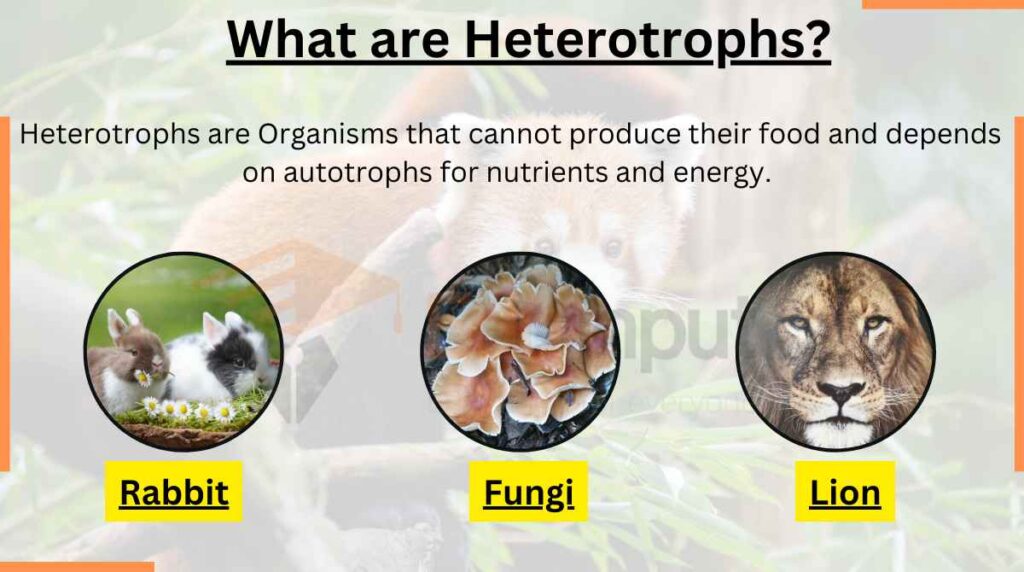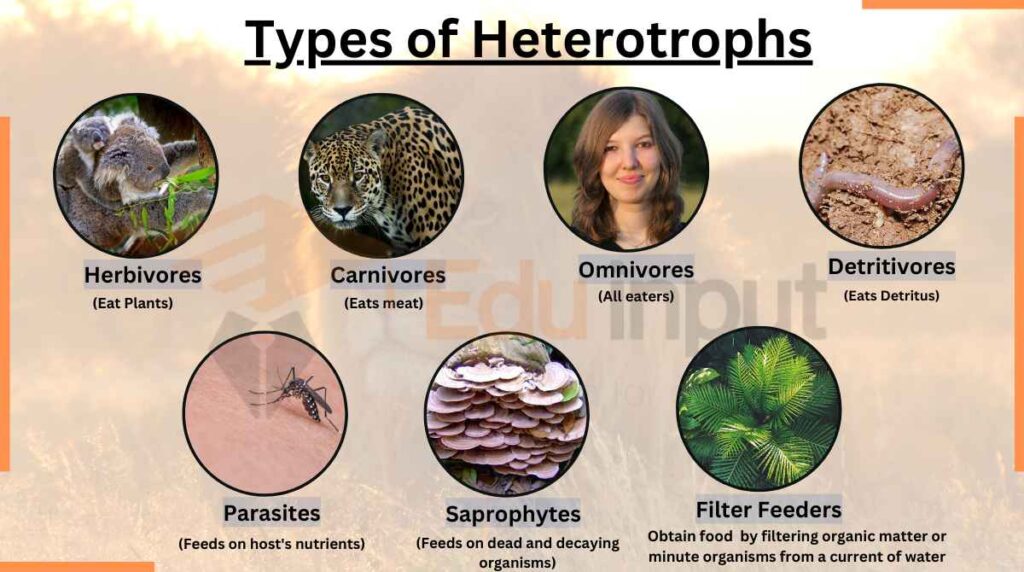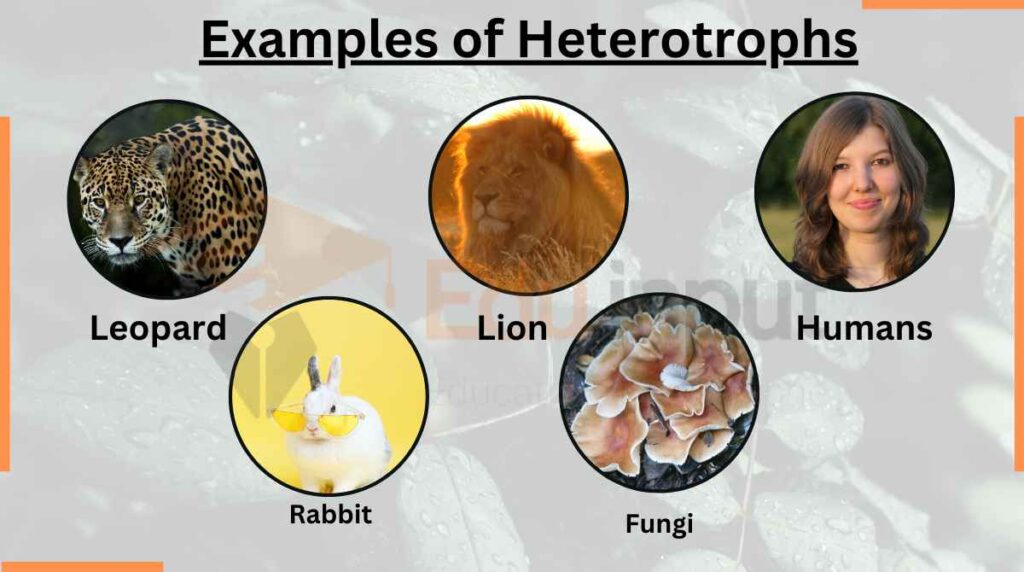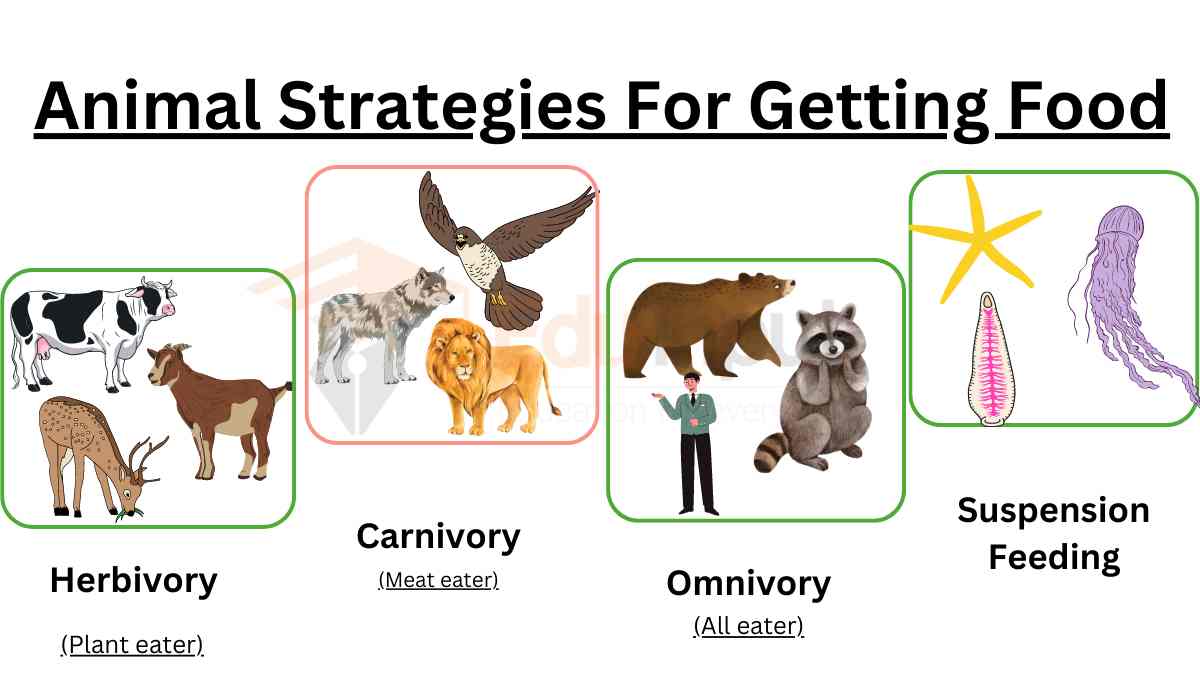Heterotrophs-Origin, Types, and Examples
Heterotrophs are Organisms that cannot produce their food and depends on autotrophs for nutrients and energy.

See more differences here: Difference Between Heterotrophs And Autotrophs
What are heterotrophs in an Ecosystem?
In an ecosystem, Heterotrophs function as consumers, which means they consume other living organisms to obtain energy.
Heterotrophs primarily occupy the second and third trophic levels in a food chain. They function as consumers, feeding on other organisms. Heterotrophs can be classified as primary consumers, which feed directly on autotrophs (plants or algae), or as secondary and tertiary consumers, which feed on other heterotrophs.
Some heterotrophs also serve as decomposers that break down organic matter and use it to get energy.
Origin of Heterotrophs
Heterotrophs have been around since the early stages of life on Earth. When life began, the environment consisted of simple chemicals and gases. It took a while for organisms that could produce their own food to grow and develop. Before that, heterotrophs were the main forms of life that uses the available organic matter for their survival.
Types of Heterotrophs
There are 7 main types of heterotrophs:

1. Herbivores
Herbivores are heterotrophs that primarily consume plants and plant-based materials as their source of energy. They have specialized digestive systems that allow them to extract nutrients from the cellulose found in plant cell walls. Herbivores play an important role in ecosystems by controlling plant growth and acting as primary consumers.
Examples of herbivores include cows, rabbits, deer, caterpillars, and grasshoppers.
2. Carnivores
Carnivores are heterotrophs that mainly feed on other animals. They have adaptations such as sharp teeth and claws, as well as well-developed senses like sight and hearing to aid in hunting and capturing their prey.
Carnivores are considered secondary or tertiary consumers in food chains, as they obtain their energy by consuming other heterotrophs.
Examples of carnivores include lions, tigers, wolves, eagles, and snakes.
3. Omnivores
Omnivores are heterotrophs that have a varied diet, consuming both plants and animals. They have a diverse set of teeth that allow them to eat a wide range of food types. Omnivores are considered opportunistic feeders, able to adapt to different food sources based on availability. Humans, bears, raccoons, pigs, and crows are examples of omnivorous heterotrophs.
4. Detritivores
Detritivores are heterotrophs that feed on dead organic matter, such as decaying plants and animal remains. They play an important role in the decomposition process, breaking down organic material into simpler compounds. Detritivores contribute to nutrient recycling and soil formation. Examples of detritivores include earthworms, millipedes, and some species of beetles.
5. Parasites
Parasites are heterotrophs that live and feed on other organisms, known as hosts, often causing harm or disease. They obtain nutrients from their hosts while potentially weakening or even killing them. Parasites have specialized adaptations that allow them to attach, invade, or live within the host’s body. Examples of parasites include ticks, fleas, lice, and certain types of worms.
6. Saprophytes
Saprophytes are also known as saprobes. They are heterotrophs that obtain their energy by decomposing dead organic matter. They play an important role in the breakdown and recycling of organic material in ecosystems. Saprophytes secrete enzymes that break down complex organic compounds into simpler forms that they can absorb. Examples of saprophytes include fungi, such as mushrooms and molds.
7. Filter Feeders
Filter feeders are heterotrophs that obtain their food by filtering small particles from the water or air. They have specialized structures or mechanisms that allow them to trap or strain food particles. Filter feeders can be found in aquatic environments, where they extract nutrients from the surrounding water. Examples of filter feeders include baleen whales, clams, and some species of fish.
Heterotrophic Plants
Unlike most plants, heterotrophic plants cannot produce their own food through photosynthesis. Heterotrophic plants have evolved these specialized strategies to survive in environments where sunlight or nutrients may be limited.
They use parasitic modes of nutrition. They obtain nutrients and energy by parasitizing or feeding on other organisms.
One example of a heterotrophic plant is the dodder, which is a parasitic plant that wraps its stem around other plants and absorbs nutrients from them.
Venus flytrap is another example. It captures and digests insects to obtain nutrients.
Examples of Heterotrophs
Heterotrophs can be found in almost every ecosystem on Earth. Here are examples of Heterotrophs:

- Fungi are heterotrophs. Fungi, like mushrooms and molds, are heterotrophic decomposers that obtain their energy by breaking down dead organic matter.
- Protists can either be heterotrophs, autotrophs (algae-like protists), or decomposers (fungi-like protists). Many protists, such as amoebas and paramecia, are heterotrophs that feed on other organisms or organic matter in their environment.
- Numerous eubacteria, like Escherichia coli, are heterotrophs that obtain energy by consuming organic material in various habitats.
- Some bacteria, such as the cyanobacteria that perform photosynthesis, are autotrophs, while others, like Salmonella, are heterotrophs that obtain energy by consuming organic matter.
- A rabbit is an herbivorous heterotroph that eats grass, leaves, and vegetables.
- A lion is a carnivorous heterotroph that hunts and eats other animals like zebras and antelopes.
- Human is an omnivorous heterotroph that consumes a wide range of foods, including fruits, vegetables, meat, and dairy products.
- Caterpillar is an herbivorous heterotroph that feeds on plant leaves.
- Hawk is a carnivorous heterotroph that catches and eats smaller birds and rodents.
- Crocodile is a carnivorous heterotroph that preys on fish, birds, and mammals.
- Squirrel is an omnivorous heterotroph that eats nuts, seeds, fruits, and occasionally insects or small animals.
- Penguin is a carnivorous heterotroph that feeds on fish and krill.
- The butterfly is an herbivorous heterotroph that feeds on the nectar of flowers.
- Spider is a carnivorous heterotroph that catches and consumes insects.
Latest Research about Heterotrophs
- Scientists have reconstructed and curated a genome-scale metabolic model of Vibrio splendidus 1A01, an early colonizer of synthetic chitin particles in seawater. By using flux balance analysis and addressing the challenges specific to modeling a marine microorganism, they gained insights into its metabolism and better understanding of its metabolic pathways. [1]
- Scientists have found that in sunlit waters, unicellular mixotrophs, which are predators with plastids, play a significant role in predation, but their success depends on how well they acquire prey compared to specialized heterotrophs, and their impact on productivity and element cycling depends on consumption rates and efficiency relative to heterotrophs, which vary among taxa and cell size. [2]
Faqs–Frequently Asked Questions
Paramecium are heterotrophs. how do they obtain nutrients from their surroundings?
Paramecium obtains nutrients from their surroundings through phagocytosis, where they capture food particles using their oral grooves and digest them in food vacuoles.
Are all animals heterotrophs?
Yes, all animals are heterotrophs. They depend on organic matter, such as other organisms or their byproducts, for energy and nutrients.
How does photosynthesis benefit heterotrophs?
Photosynthesis benefits heterotrophs by providing them with food and oxygen through the production of glucose and the release of oxygen by autotrophs.
Are archaebacteria autotrophs or heterotrophs?
Archaebacteria can be either autotrophs or heterotrophs, depending on the species and their metabolic capabilities.

 written by
written by 


Leave a Reply